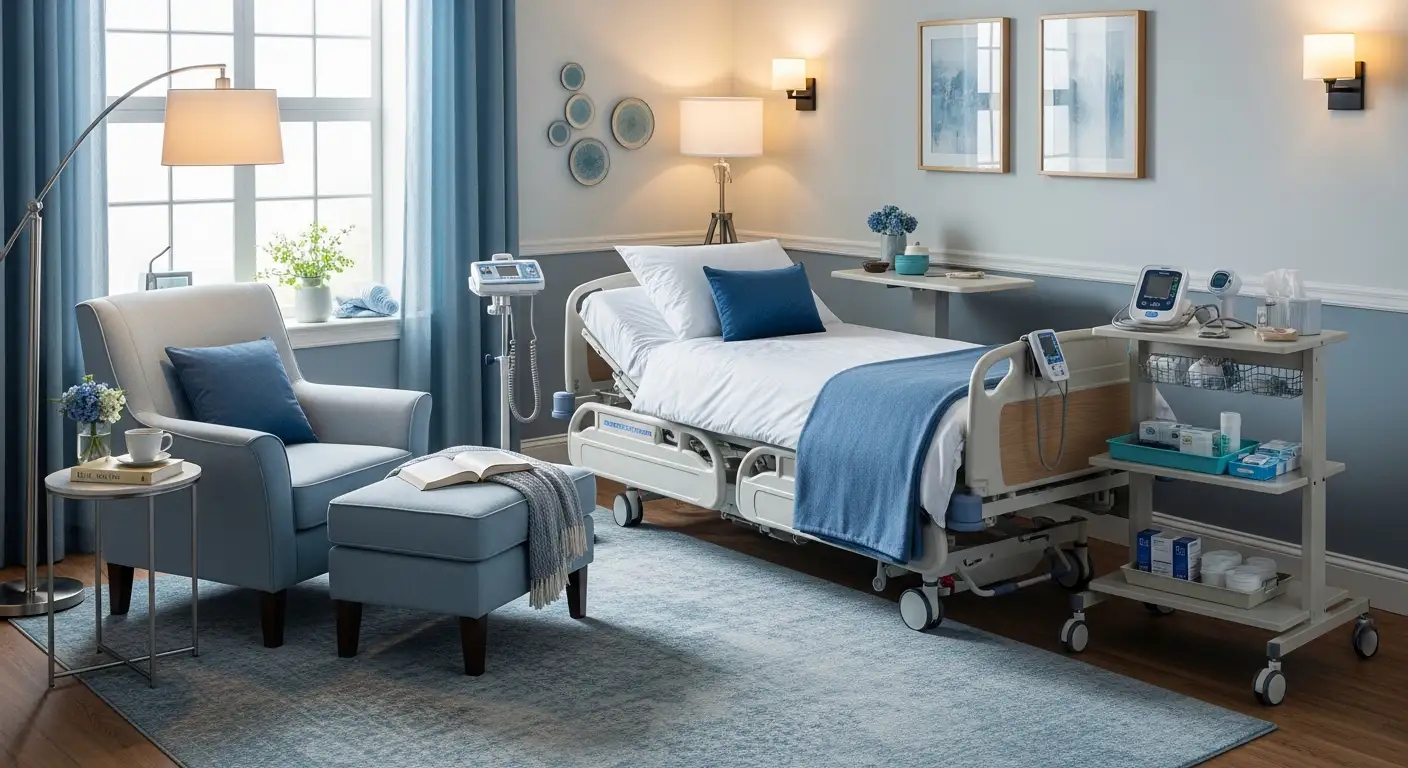Introduction to Home Ventilator Care
Providing ventilator support at home is a critical component for patients with chronic respiratory conditions, enabling them to breathe more comfortably and reducing hospital stays. Achieving safe and effective ventilator care in a home setting requires meticulous preparation, ongoing management, and adherence to safety protocols. This article explores comprehensive strategies for ensuring optimal ventilator use outside the hospital, emphasizing equipment setup, patient monitoring, caregiver education, and safety measures.
Preparing the Home Environment for Ventilator Use

What are key considerations for setting up the home environment?
Preparing a home for ventilator use requires careful planning to ensure safety, comfort, and functionality.
First, assess the physical space available. A dedicated, clutter-free area with enough room for equipment setup helps facilitate easier operation and monitoring.
Next, ensure the home is equipped with the necessary electrical outlets. Many ventilators and related devices need reliable sources of power, so installing surge protectors and ensuring outlets are accessible and safe is essential.
Safety features such as smoke detectors and carbon monoxide alarms should be in place. Additionally, evaluating airflow and ventilation is vital: opening windows slightly or widely can improve air exchange.
Promoting outdoor air circulation with fans directed away from occupants can help reduce airborne contaminants, including viruses.
The home should also support the setup of auxiliary equipment like backup ventilators, batteries, suction machines, humidifiers, pulse oximeters, and nebulizers.
Finally, regular assessment of the environment to adapt to changing needs ensures a safe and comfortable atmosphere for continuous ventilator use.
How do you ensure equipment readiness and safety?
Ensuring all ventilator and auxiliary equipment is ready involves thorough pre-use checks. Inspect circuits, filters, and humidifiers for damage or wear before each use.
Regular maintenance and professional inspections are crucial; if any malfunction occurs, immediate repair or replacement should be arranged to maintain safety.
Having backup supplies, such as oxygen tanks and spare ventilators, guarantees support during equipment failure or power outages.
Devices like pulse oximeters help in ongoing monitoring of the patient's oxygen levels, providing real-time data to caregivers.
Suction machines should be prepared with sterile supplies and checked to operate correctly.
Educating caregivers on how to calibrate, troubleshoot, and perform basic maintenance ensures equipment functions safely and effectively between professional checks.
In summary, proactive equipment management and safety checks are fundamental to effective home ventilator support.
Training and Education for Caregivers and Patients

What training should caregivers receive before managing ventilator support at home?
Before managing ventilator support at home, caregivers and patients must undergo detailed training from healthcare professionals, usually respiratory therapists. This training covers essential skills such as operating and adjusting the ventilator, performing routine maintenance, and recognizing signs of malfunction.
Caregivers learn to interpret alarm signals—such as high-pressure or low-pressure alarms—and respond swiftly to prevent complications. They are also taught how to clean and disinfect equipment, change filters, and troubleshoot common issues.
For pediatric patients or those requiring long-term invasive ventilation, training includes handling emergency situations like accidental dislodgement of tubes, airway blockages, or sudden equipment failure. Caregivers also gain skills in tracheostomy care, suctioning, medication administration, and CPR.
Regular re-education sessions help caregivers maintain and update their skills, build confidence, and stay informed about new equipment features or updated protocols. This ongoing education ensures that caregivers are prepared to manage complex devices safely, protect the patient, and provide optimal care.
How can ongoing training improve ventilator safety?
Continuous training is vital for ensuring safe ventilator use at home. By participating in refresher courses, practical demonstrations, and simulation exercises, caregivers reinforce their skills and knowledge.
Staying current on the latest guidelines and equipment updates allows caregivers to quickly recognize alarm signals and identify malfunctions early. This proactive approach helps prevent emergencies, such as hypoxia, accidental extubation, or infection.
Ongoing education enhances caregiver confidence, reduces errors, and promotes better adherence to safety protocols. It also equips caregivers to handle unexpected situations more effectively, ensuring the patient’s safety and comfort.
Furthermore, regular re-training fosters a culture of safety and awareness, essential for managing complex respiratory equipment in the home environment. Ultimately, continuous caregiver education plays a critical role in minimizing risks and promoting optimal patient outcomes.
Monitoring and Managing Respiratory Function at Home

What are the essential components of patient monitoring in home ventilator care?
Effective monitoring in home ventilator care involves a combination of regular assessments of vital signs, oxygen levels, and ventilation efficiency. Caregivers should routinely check respiratory rate, effort, breath sounds, and the patient’s overall comfort. Using devices like pulse oximeters, which measure blood oxygen saturation, is crucial for detecting early signs of hypoxia.
Capnography, which monitors exhaled carbon dioxide (CO₂), provides real-time data about ventilation adequacy and airway patency. Waveform analysis from capnography reveals whether the patient is ventilating properly, signaling potential issues such as airway obstruction or disconnection.
In addition, caregivers must be alert for equipment alarms, mucus buildup, and signs of respiratory distress. Proper technique in performing gentle suctioning is vital when mucus secretion impairs airflow. Caregivers should follow aseptic procedures to avoid infections and only perform suctioning when necessary.
How often should monitoring be performed?
Monitoring must be continuous during sleep and when the patient is unobserved during the day, ensuring timely detection of any problems. Throughout the day, scheduled assessments should include checking ventilator parameters such as tidal volume, pressure settings, and alarm functions.
Pulse oximetry should be employed 24/7 to continuously track oxygen saturation levels and signal any decline that might require intervention. Periodic capnography assessments during caregiver visits can help evaluate whether ventilation remains effective.
Regular documentation of vital signs, oxygen levels, and ventilator settings supports healthcare providers in tracking the patient’s progress and making necessary adjustments to support plans. Maintaining thorough records helps ensure consistent, safe, and effective respiratory management at home.
Safe Operation and Troubleshooting of Ventilators at Home
What are typical ventilator alarms and how should they be managed?
Ventilators are equipped with alarms to alert caregivers about possible issues such as high-pressure, low-pressure, apnea, or power failure. These alarms help prevent serious complications like insufficient oxygen delivery or airway obstructions.
When an alarm sounds, immediate actions include checking the patient's airway for mucus plugs or dislodgement, ensuring that all tubing and connections are secure, and inspecting the ventilator for technical issues. It is important to verify that the device is powered properly and that alarm settings are correct. If the alarm persists despite troubleshooting, caregivers should switch to manual ventilation using a bag-valve mask while contacting healthcare providers.
Proper training in alarm management is essential to respond swiftly, reducing the risk of hypoxia and other respiratory risks. This includes knowing how to silence alarms temporarily, interpret alarm messages, and prioritize interventions.
How do you troubleshoot ventilator problems at home?
Troubleshooting begins with a systematic check of the ventilator and associated equipment. First, inspect all tubing for kinks, disconnections, or blockages. Confirm that filters are clean and not obstructed, and verify the power source is active and stable.
Next, ensure the device settings match the prescribed ventilation parameters. Regular maintenance routines, such as replacing circuits and filters according to manufacturer instructions, help in maintaining optimal device performance.
If the problem remains unresolved, caregivers should avoid attempting extensive repairs. Instead, contact professional technical support or arrange for urgent repairs through healthcare providers. Maintaining a manual ventilation device like a bag-valve mask readily available provides an emergency backup.
Good practice involves being familiar with the device's manual instructions and having a clear plan for emergency troubleshooting. Regular device checks and a well-organized emergency kit can significantly enhance safety and confidence in managing home ventilator issues.
For detailed guidance, searching for terms like "ventilator troubleshooting at home best practices" can provide useful resources and checklists.
By staying informed and prepared, caregivers can ensure safe, effective ventilator use at home, supporting patients' respiratory needs while minimizing risks.
Infection Prevention and Control Measures
What practices help reduce the risk of ventilator-associated pneumonia?
Preventing infections such as ventilator-associated pneumonia (VAP) is crucial for patient safety. Implementing strict infection control practices in home and hospital settings plays a vital role.
Key measures include practicing diligent hand hygiene, such as thorough handwashing or using alcohol-based sanitizers before touching equipment or the patient. Elevating the head of the bed to between 30 and 45 degrees reduces the risk of aspiration, a common cause of pneumonia.
Regular oral care with chlorhexidine or other antiseptics helps decrease bacteria in the mouth that could be aspirated into the lungs. Routine cleaning and disinfection of equipment like circuits, filters, and suction catheters are necessary to prevent bacterial growth.
Using sterile or aseptic suctioning techniques ensures that pathogens are not introduced into the airway during routine care. Minimizing circuit changes, unless equipment is contaminated or malfunctioning, also reduces infection risk.
Adherence to these practices can significantly lower the incidence of ventilator-associated pneumonia, leading to improved health outcomes and faster recovery.
How can caregivers maintain equipment hygiene?
Maintaining equipment hygiene is essential to prevent infections and ensure the proper functioning of ventilator devices. Caregivers should regularly clean and disinfect reusable parts such as masks, humidifiers, and tubing using approved solutions like vinegar or manufacturer-recommended disinfectants.
Disposable components, including filters, suction catheters, and inflatable cuff seals, need to be replaced per the advised schedule, typically guided by insurance or manufacturer instructions. Timely replacement prevents build-up of bacteria and blockages.
Thorough handwashing before and after handling ventilator equipment minimizes contamination. Practicing aseptic techniques during every procedure—like suctioning or tracheostomy care—also reduces pathogen transmission.
By diligently following these steps, caregivers can create a safer environment, reduce infection risks, and promote effective respiratory therapy at home.
Understanding Ventilator Support Types and Settings
What are the different types of ventilator support available for home use?
Home ventilators can provide support either invasively or noninvasively. Invasive ventilation involves inserting a tube directly into the windpipe (trachea), usually through a surgical opening called a tracheostomy. This method is often used for patients requiring long-term respiratory support or severe airway issues.
Noninvasive ventilation, on the other hand, uses masks that fit over the nose or face, such as Continuous Positive Airway Pressure (CPAP) or Bilevel Positive Airway Pressure (BiPAP) devices. These are preferred for conditions like sleep apnea or milder respiratory impairments, as they are generally more comfortable and easier to manage.
Modern devices for home use are equipped with features like portability, remote monitoring, and humidification to enhance patient comfort and mobility. The choice between invasive and noninvasive support is based on the patient's medical condition, anatomy, and overall treatment goals, always under healthcare team supervision.
How are ventilator settings managed at home?
Managing ventilator settings at home requires precise adjustments to support optimal breathing while ensuring safety. Essential parameters include tidal volume, respiratory rate, inspired oxygen fraction (FiO₂), and positive end-expiratory pressure (PEEP). These settings are tailored to meet individual needs, which are determined through clinical assessments and ongoing monitoring.
Adjustments must only be made under the guidance of healthcare professionals like respiratory therapists or physicians. Regular evaluation involves monitoring ventilator alarms, blood oxygen and carbon dioxide levels, and clinical signs of respiratory distress.
Troubleshooting common issues such as high airway pressures, leaks, or low ventilation involves understanding the device's alarms and functions. Prompt technical interventions, including equipment repairs or re-calibration, are vital to prevent complications. Proper training and ongoing communication with the care team are crucial for maintaining effective and safe ventilator support at home.
Professional Resources and Clinical Guidelines for Home Ventilator Care

What guidelines exist for managing ventilator care at home?
Guidelines from authoritative organizations like the American Thoracic Society (ATS) and established clinical practice guidelines (CPGs) serve as essential references for home ventilator management. These guidelines emphasize thorough planning, including careful assessment of patient readiness, proper caregiver training, and environmental safety measures.
They recommend a multidisciplinary team approach involving physicians, respiratory therapists, nurses, and social workers to coordinate comprehensive care. Standardized discharge criteria help determine when a patient is stable enough to be cared for at home. Regular follow-up visits and ongoing assessments are crucial to monitor the patient's respiratory status, adjust ventilator settings appropriately, and prevent complications.
Safety protocols such as emergency preparedness, equipment maintenance, and patient comfort are also prioritized within these guidelines. Structured training for caregivers and periodic competency evaluations ensure that the home care team remains skilled. This integrated approach promotes patient safety, improves quality of life, and reduces hospital readmissions.
Why is interdisciplinary communication important in home ventilator management?
Effective communication among all members of the healthcare team—including physicians, respiratory therapists, nurses, and home caregivers—is critical for safe and effective ventilator management. Clear, consistent documentation and regular team meetings support coordinated decision-making, whether adjusting ventilator settings, troubleshooting equipment, or responding to emergencies.
Sharing clinical information ensures that everyone is informed about recent changes in the patient's condition, recent interventions, and potential risks. It reduces errors and enhances patient outcomes by fostering a collaborative environment.
In practice, interdisciplinary communication guarantees that modifications to treatment plans are well-understood, and that ventilator adjustments are made with consensus, maintaining safety and comfort. It promotes a patient-centered approach where all team members work together seamlessly, ultimately supporting better health and safety outcomes for patients on home ventilation.
Long-term Management, Follow-up, and Emergency Preparedness
 Proper ongoing care for patients using home ventilators is essential to ensure safety, comfort, and the effectiveness of therapy. Regular follow-up visits are a cornerstone of long-term management. These visits are typically scheduled starting the day after hospital discharge and initially occur more frequently, such as weekly or biweekly, then taper to monthly sessions. During these visits, respiratory therapists or specialized nurses check the ventilator's functioning, assess the patient's respiratory status, and evaluate adherence to therapy.
Proper ongoing care for patients using home ventilators is essential to ensure safety, comfort, and the effectiveness of therapy. Regular follow-up visits are a cornerstone of long-term management. These visits are typically scheduled starting the day after hospital discharge and initially occur more frequently, such as weekly or biweekly, then taper to monthly sessions. During these visits, respiratory therapists or specialized nurses check the ventilator's functioning, assess the patient's respiratory status, and evaluate adherence to therapy.
Routine maintenance of equipment includes cleaning masks and circuits, replacing filters, inspecting and servicing the ventilator, and ensuring backup systems are operational. This ongoing oversight helps prevent complications and prolongs equipment lifespan.
Emergency preparedness significantly enhances safety by ensuring rapid response during unexpected events like power outages, equipment failure, or urgent health deteriorations. Families should be equipped with backup devices such as portable ventilators and batteries, along with supplies like oxygen tanks and replacement parts. Creating a clear crisis response plan, which includes contacting emergency services and healthcare providers, is vital.
Training caregivers on emergency procedures, such as manual ventilation with a bag-valve mask and recognizing signs of deterioration (e.g., increased respiratory distress, low oxygen saturation), is crucial. Regular drills or rehearsals can help caregivers remain confident and prepared.
Furthermore, maintaining open communication with utility companies can prevent interruptions caused by outages, especially in areas prone to blackouts. Informing local emergency services of the patient’s needs ensures prompt assistance if required.
In summary, combining scheduled follow-up appointments, vigilant equipment maintenance, comprehensive caregiver training, and well-developed emergency plans creates a safe environment for patients dependent on ventilator support at home. These measures reduce risks, improve outcomes, and provide peace of mind for both patients and their families.
Concluding Remarks on Home Ventilator Safety
Providing safe and effective ventilator care at home requires a coordinated approach encompassing meticulous environment preparation, comprehensive caregiver training, diligent patient monitoring, strict infection control, and rigorous safety protocols. The integration of advanced technology, clear communication among healthcare teams, and ongoing education empower caregivers and patients alike to manage ventilation effectively. Regular follow-up, prompt troubleshooting, and emergency preparedness further safeguard patient health, enable improved quality of life, and foster confidence in home-based respiratory support. With these strategies, home ventilator care can be a safe, comfortable, and sustainable solution for individuals with chronic respiratory needs.
References
- Going Home on a Ventilator
- The Patients Guide to Home Ventilator Care
- Home Ventilator Services | Johns Hopkins Care at Home
- Improving Ventilation in Your Home
- Powering Success in Home Mechanical Ventilation | RT
- Top 10 Essentials: Care of Patients on Ventilators.
- Guidelines for Ventilator Care at Home
- Ventilator Safety - StatPearls



